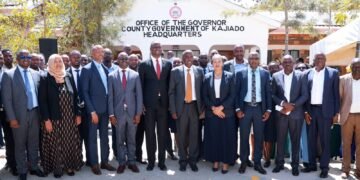The Ghana Revenue Authority has announced that its efforts to increase revenue mobilisation are yielding the needed results, with data showing that the Ghana Revenue Authority (GRA) beat its target for last year by GH¢265.39 million.
The authority collected GH¢57.32 billion in revenue in 2021, against the target of GH¢57.055 billion, mainly as a result of plugging the loopholes for tax avoidance by some multinationals in the extractive sector, the deployment of digital and specialised monitoring platforms for tax collection purposes and increased attention on sectors of the economy that showed growth.
The amount collected last year was about GH¢265.39 million or 0.5 per cent above the target the government set for the GRA, and the achievement came at a time the COVID-19 pandemic had dampened growth in businesses and the economy in general.
As a result of the strong growth in revenue last year, the ratio of tax to gross domestic product (GDP), which measures the share of economic output collected in taxes to fund development, rose to 13.4 per cent, having hovered around 12 per cent in recent years.
Breakdown
The Commissioner-General of the GRA, Rev. Dr Ammisshaddai Owusu-Amoah, said both domestic tax revenue and customs receipts of the authority performed creditably well.
While domestic tax revenue amounted to GH¢41.23 billion for last year, representing an improvement of 25.6 per cent over the 2020 revenue, the Customs Division of the authority mobilised GH¢16.08 billion, representing a 26.8 per cent increase over the 2020 performance, he said.
He explained that unlike in recent years when revenue targets were revised downwards to reflect prevailing economic conditions, last year’s target was not revised, making the amount realised a significant feat.
He noted that the realised revenue figure also broke and set new records, including recording the highest annual growth rate in 10 years and being the biggest ratio of revenue-to-GDP in five years.
Reasons
Rev. Dr Owusu-Amoah said the feat was as a result of the deployment of digital platforms for the filing of returns and payment of taxes, which enhanced the GRA’s capacity to mobilise revenue in the pandemic.
It was also due to the new strategy to place increased focus on businesses in growth-driven sectors, such as the extractive, information and communications technology (ICT) and financial sectors.
He said although the pandemic had marginalised businesses, an internal study showed that the sectors were enjoying tremendous growth, hence the decision to increase attention on them for the purposes of revenue mobilisation.
He disclosed that the GRA also enhanced the capacity of its management and staff to pursue multinational companies, especially those in the extractive sector, for the purpose of collecting appropriate revenue from them.
That, the commissioner-general said, resulted in a significant reduction in tax avoidance measures by companies, such as transfer pricing and a corresponding increase in their taxable income.
“Most of the companies operating in the extractive sector are multinationals and one of the things they do is undertake profit shifting and base erosion. They find ways to move the profit somewhere, and that reduces the amount of taxes they will pay to us. But we found a way around this,” he said.
He explained that the authority built the capacity of its staff to identify and block those loopholes, thereby compelling the firms to pay the right taxes to the state.
“So the effective and better understanding of transfer pricing enables you to handle these things for the purposes of taxation, and that is what we did last year; we are going to do more this year,” Rev. Dr Owusu-Amoah said.
Digitalisation
Explaining further, he said, the feat was also attributable to the increased digitalisation of revenue collection that allowed taxpayers to file returns and pay taxes online, as well as through digital platforms.
He said the introduction of the Integrated Customs Management Systems (ICUMS) to streamline customs operations and a monitoring system to track downstream petroleum activities also contributed to the increase in customs revenue collection.
“Most importantly, these achievements in 2021 are also due to an improved and positive work attitude by the management and staff of the authority. Their commitment to this performance cannot be understated,” he said.
Transformation agenda
Rev. Dr Owusu-Amoah said last year’s feat had energised the management and staff of the authority to meet and possibly exceed this year’s target.
He said the GRA’s transformation agenda that hinged on making tax payment and the filling of returns more convenient for taxpayers, as well as tracking business activities to ensure that all revenues were collected, was also yielding the needed results.
“In addition, the cashless policy, which allows taxpayers to pay taxes online and at the banks, and the taxpayers’ portal, which allows taxpayers to file returns in the comfort of their homes, have brought transparency and efficiency into tax administration and collection,” he said.
Previous targets
Since 2017, the GRA has grown revenue collection by double digits on an annual basis, except in 2020, when the amount mobilised inched up by just 3.4 per cent, largely as a result of the outbreak of the COVID-19 pandemic.
Data available to the Daily Graphic indicate that annual tax revenue grew by 22.4 per cent in 2017, 16.6 per cent in 2018 and 16.5 per cent in 2019, before slumping to 3.4 per cent in 2020.
Since 2017, the targets had been revised downwards in the midyear budget reviews to reflect prevailing economic conditions. Last year’s target was, however, not revised downwards, in spite of the raging pandemic.
Source: GraphicOnline





























































